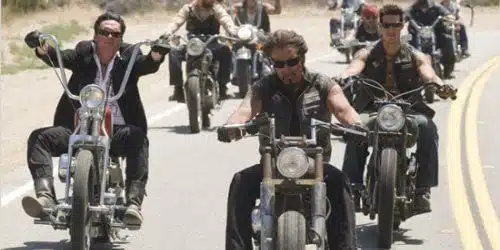
There is is a big difference between legitimate cool and faked cool. The real thing is hard to define and rather ephemeral. It exudes off the subject – film, album, individual – in ways that literally defy description. The counterfeit version is easy to spot. It announces itself like an overly tan lounge lizard in tacky gold chains, and demands that you respect its forced bravado. The latest attempt at recapturing the exploitation vibe from three decades ago, Hell Ride, has a decent pedigree. Executive produced by Quentin Tarantino and created by old school drive-in vet Larry Bishop (Wild in the Streets, The Savage Seven), this is yet another contemporary tap into the original post-modern movie ideal. Unfortunately, the few things this grindhouse wannabe gets right can’t compensate for a distinct aura of unnatural swagger.
Back in ’76, biker Pistolero promised the soon-to-be-murdered Cherokee Kisum that he would protect a key to a safety deposit box. The contents – supposedly untold amounts of drug money – were for her son, Comanche. Now, over four decades later, an older Pistoler leads the vagabond gang known as the Victors, along with his right hand man The Gent. When member St. Louie is killed by the rogue renegade 666’ers, led by the notoriously unsane Billy Wings and The Deuce, he vows vengeance. He also hopes to locate the last two keys so that Comanche (now part of his crew) can earn his birthright and satisfy the age old vendetta. Of course, any action against the 666’ers will upset the status quo, and that means an end to beer and babes and the beginning of an all out motorcycle holocaust.
Right from the very first image, Hell Ride comes off as a Devil’s Rejects reject. Unfortunately, you quickly realize that Rob Zombie was much more in tune with the exploitation ethic than wannabe Mahon Larry Bishop. Soon, the Tarantino nods start pouring in, staid amalgamations of spaghetti westerns, Asian crime dramas, and overworked schlock motifs. About 40 minutes in you’ve had enough. You can’t stand the back and forth posing, the hopscotching homages, the lack of anything remotely looking like a linear narrative or dimensional character. It’s at this moment when cast and crew make their stand, demanding that you accept them, or simply ignore their over-earnest motion picture pastiche outright and move along. If you can handle such a head on aesthetic collision, you just might enjoy the last act.
But if you don’t, Hell Ride will seem like a literal journey into Satan’s gaping maw. It will test your bare breasting faculties and push the very limits of your need for unnecessary posturing. There is no acting here, just useless channeling of personas past, and when he can’t think of anything clever to convey, writer/director Bishop simply tosses out a few Leone riffs and calls it a day. There are so many mock meaningful close-ups, uses of zoom and soft focus falderal that you swear Guy Madden had discovered the ’60s and was updating his canon of D.W. Griffith-inspired artiness. Processed to purgatory and back in post-production, the movie tries to super saturate some depth into what is, in essence, a nostalgia borne out of boredom. This is about as ‘grindhouse’ as the similarly styled (and named) films released by QT and his buddy Robert Rodriguez early last year.
Still, if you can stomach Bishop’s bravado, if you can get behind his cut and paste imagination, you may cotton to this Ride. There are definitely scenes that spark with untapped potential. Michael Madsen’s Gent takes on Eric Balfour’s Comanche in a one on one bar fight that discovers some heretofore untapped humor. There is another hilarious moment when a sheepish Dennis Hopper asks a biker babe for a joint (his face is classic). Sure, for every segment that gets you smiling, there’s one like Bishop’s “fire” based stand-off with his ‘old lady’, the lovely Cassandra Hepburn. The duo tosses so many conflagration entendres at each other that you can actually count the ones that ‘burn’, and the many that merely irritate. Some of this film feels like it would read better on the page. Besides, trying to mimic the crudity of the past is no longer clever.
Indeed, this is Hell Ride‘s biggest problem. Very few filmmakers can accurately recreate the look and feel of ancient b-grade drive-in fare. Zombie is one. The Manson Family‘s Jim Van Bebber is another. Not only do they capture the visuals, they understand the off the cuff, on the run nature of how many of these movies were shot. To suggest that this can be done in some geek’s laptop is ludicrous. Besides, Bishop should know better. He was around when this kind of cinema ruled the subculture, and even acted in a few famous examples. Here, he seems to be looking through digital rose colored glasses. Everything plays like a flashback – albeit one told in a terrific, flashy style that tries desperately to hide how cornball the motoring and machismo really are.
All one can do is submit to Hell Ride‘s ridiculousness and simply allow the movie to make up its own creative logic. You might actually find that you like Bishop’s Birdman of Razzmatazz personality (he’s all grumbles and Van Dykes). If you don’t mind wallowing in excess that never achieves the T&A bounty the narrative suggests (here’s hoping the Unrated DVD solves this problem, pronto), you could find yourself fooled. Had he simply made a standard biker flick, a post-modern update of an old fashioned raincoat crowder, Larry Bishop’s ambition might be more acceptable. But combining 2008 with 1968 (or ’78) just won’t work, and by the time you’ve surrendered to Hell Ride‘s chopper chic surrealism, you’ll realize what a true waste of time it’s been.
